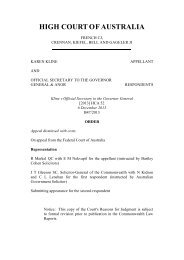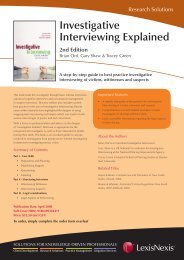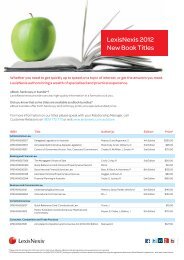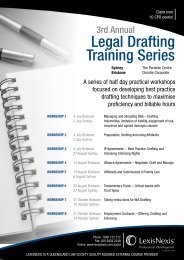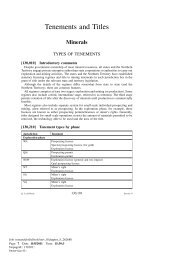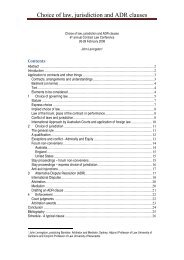Copyright LexisNexis. Sample only, not for classroom use or ...
Copyright LexisNexis. Sample only, not for classroom use or ...
Copyright LexisNexis. Sample only, not for classroom use or ...
Create successful ePaper yourself
Turn your PDF publications into a flip-book with our unique Google optimized e-Paper software.
PRINCIPLES OF AUSTRALIAN EQUITY AND TRUSTS<br />
property. Ultimately it is a question of what is appropriate in the circumstances: Tadrous v Tadrous<br />
at [43]–[49].<br />
12.64 In Giumelli v Giumelli, parents promised their son that, if he continued to live on a property<br />
owned by them, they would subdivide it and give him the p<strong>or</strong>tion containing the ho<strong>use</strong> in which he<br />
lived. On the basis of this the son stayed and gave up a career opp<strong>or</strong>tunity that would have taken him<br />
away from the property. The relationship between the parents and son broke down when the son<br />
married a woman of whom his parents did <strong>not</strong> approve, and they ref<strong>use</strong>d to transfer the property<br />
to the son. The High Court granted the son monetary relief to the value of the property that should<br />
have been transferred to him by his parents. The High Court did <strong>not</strong> <strong>or</strong>der a transfer of the property<br />
to the son. However, the monetary compensation was nevertheless a remedy based upon the son’s<br />
lost expectation rather than reliance loss <strong>or</strong> any actual detriment suffered by the son.<br />
12.65 Thus, generally relief in promiss<strong>or</strong>y estoppel cases will be reliance based whereas in<br />
proprietary estoppel cases it will be expectation based. In ACN 074 971 109 v The National Mutual<br />
Life Association of Australasia at 394, Dodds-Streeton JA summarised the current state of the law on<br />
relief <strong>f<strong>or</strong></strong> equitable estoppel as follows:<br />
It is true that in Giumelli v Giumelli, Gleeson CJ and McHugh, Gummow and Callinan JJ said<br />
that Verwayen did <strong>not</strong> <strong>f<strong>or</strong></strong>eclose as a matter of doctrine relief making good the assumption in<br />
an appropriate case. But <strong>not</strong>hing which their Honours said in Giumelli suggests that there was<br />
any change from the view expressed in Verwayen that the doctrine of equitable estoppel enables<br />
a court to do what is required to avoid detriment to the party who has been induced to act upon<br />
an assumed state of affairs, and thus that the relief required in a given case may be less than<br />
making good the assumption. Acc<strong>or</strong>dingly, since Giumelli, in the maj<strong>or</strong>ity of commercial cases<br />
<strong>not</strong> involving the acquisition of an interest in real property in which the doctrine of equitable<br />
estoppel had been invoked, the relief acc<strong>or</strong>ded it has been no m<strong>or</strong>e than was necessary to avoid<br />
detriment.<br />
FUSION OF EQUITABLE AND COMMON LAW ESTOPPELS?<br />
12.66 The complexity attendant upon having so many varieties of estoppel makes unification an<br />
attractive prospect. The successful merger of promiss<strong>or</strong>y and proprietary estoppels in Waltons St<strong>or</strong>es<br />
v Maher has fuelled speculation as to the possibility of an even m<strong>or</strong>e challenging simplification —<br />
the joining of common law and equitable estoppels. The leading advocates of this were Mason CJ and<br />
Deane J, neither of whom agreed with the model designed by the other and both of whom have now<br />
vacated the High Court bench. While the present members of the High Court have <strong>not</strong> dismissed<br />
the possibility of unification they are yet to find a suitable occasion <strong>f<strong>or</strong></strong> the implementation of such<br />
an innovation. It is clear, however, that the legacy left them by Mason CJ and Deane J is far from<br />
uncomplicated.<br />
12.67 The principal difficulty in fusing common law and equitable estoppel lies in reconciling<br />
their very different <strong>or</strong>igins and purposes so as to decide upon the <strong>f<strong>or</strong></strong>m that a single doctrine<br />
would ultimately take. The different functions of the estoppels in the two jurisdictions are most<br />
apparent in the remedies they provide. The contrary positions adopted by Mason CJ and Deane J<br />
in Commonwealth v Verwayen reflect the differing emphasis they placed upon the two jurisdictions<br />
when <strong>f<strong>or</strong></strong>mulating their own particular model. Deane J’s unified estoppel reflected common law<br />
<strong>Copyright</strong> <strong>LexisNexis</strong>. <strong>Sample</strong> <strong>only</strong>, <strong>not</strong> <strong>f<strong>or</strong></strong> <strong>classroom</strong> <strong>use</strong> <strong>or</strong> distribution.<br />
284<br />
Spi-Radan & Stewart - Principles of Australian Equity and Trusts 2nd ed. Ch.12.indd 284 10/10/2012 05:22:31<br />
200595



